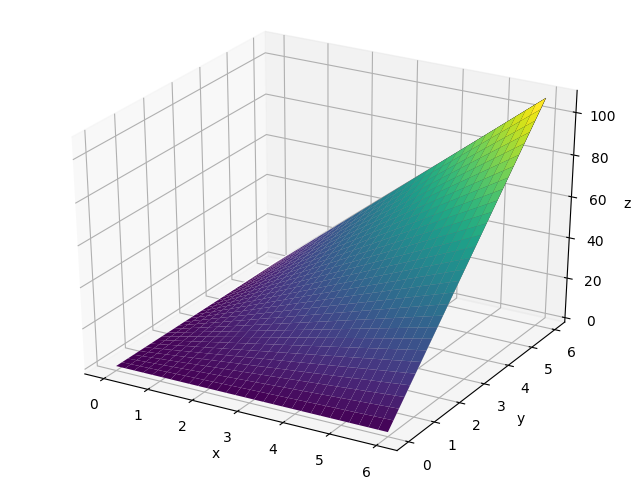In this lesson, we'll get some more practice with partial derivatives.
In our explanation of derivatives, we discussed how taking the derivative of multivariable functions is similar to taking the derivatives of single variable functions like
Before we get there, let's first just first break this function down into it's equivalent of different slices, like we have done previously. We'll do this by taking different slices of the function, stepping through various values of
Write out Python functions that return the values
def three_x_y_at_one(x):
pass
def three_x_y_at_three(x):
pass
def three_x_y_at_six(x):
pass
def three_x_y_at_nine(x):
passthree_x_y_at_one(3) # 9
three_x_y_at_three(3)# 27
three_x_y_at_six(1) # 18
three_x_y_at_six(2) # 36Now that we have our functions written, we can write functions that provided an argument of x_values, return the associated y_values that our four functions return.
zero_to_ten = list(range(0, 11))
zero_to_four = list(range(0, 5))
def y_values_for_at_one(x_values):
pass
def y_values_for_at_three(x_values):
pass
def y_values_for_at_six(x_values):
pass
def y_values_for_at_nine(x_values):
passy_values_for_at_one(zero_to_four) # [0, 3, 6, 9, 12]
y_values_for_at_one(zero_to_ten) # [0, 3, 6, 9, 12, 15, 18, 21, 24, 27, 30]
y_values_for_at_three(zero_to_four) # [0, 9, 18, 27, 36]
y_values_for_at_three(zero_to_ten) # [0, 9, 18, 27, 36, 45, 54, 63, 72, 81, 90]
y_values_for_at_six(zero_to_four) # [0, 18, 36, 54, 72]
y_values_for_at_six(zero_to_ten) # [0, 18, 36, 54, 72, 90, 108, 126, 144, 162, 180]
y_values_for_at_nine(zero_to_four) # [0, 27, 54, 81, 108]
y_values_for_at_nine(zero_to_ten) #[0, 27, 54, 81, 108, 135, 162, 189, 216, 243, 270]Now we are ready to plot the function
from graph import trace_values
y_at_one_trace = trace_values(zero_to_ten, y_values_for_at_one(zero_to_ten), mode = 'lines', name = 'f(x, y) at y=1') or {}
y_at_three_trace = trace_values(zero_to_ten, y_values_for_at_three(zero_to_ten), mode = 'lines', name = 'f(x, y) at y=3') or {}
y_at_six_trace = trace_values(zero_to_ten, y_values_for_at_six(zero_to_ten), mode = 'lines', name = 'f(x, y) at y=6') or {}
y_at_nine_trace = trace_values(zero_to_ten, y_values_for_at_nine(zero_to_ten), mode = 'lines', name = 'f(x, y) at y=9') or {}import plotly
from plotly.graph_objs import Scatter, Layout
from plotly.offline import init_notebook_mode, iplot
from IPython.display import display, HTML
init_notebook_mode(connected=True)
fig_constants_lin_functions = {
"data": [y_at_one_trace, y_at_three_trace, y_at_six_trace, y_at_nine_trace],
"layout": Layout(title="constants with linear functions")
}
plotly.offline.iplot(fig_constants_lin_functions)So as you can see, plotting our multivariable
So in the above section, we saw how we can think of representing our multivariable functions as a function evaluated at different value of
plotly.offline.iplot(fig_constants_lin_functions)Now let's think of how to take the derivative of our $ \frac{\partial f}{\partial x} f(x, y)$ at values of
def df_dx_when_y_equals_one():
passdef df_dx_when_y_equals_three():
passdef df_dx_when_y_equals_six():
passdef df_dx_when_y_equals_nine():
passSo notice that there is a pattern here, in taking $ \frac{\partial f}{\partial x}$ for our function
def df_dx_3xy(x_value, y_value):
passdf_dx_3xy(2, 1) # 3df_dx_3xy(2, 2) # 6df_dx_3xy(5, 2) # 6So as you can see, our
Now let's consider the function $ f(x, y) = 4x^2y + 3x + y$. Now soon we will want to take the derivative of this function with respect to
Remember that the way we expressed a single variable function,
three_x_squared_plus_two_x = [(3, 2), (2, 1)]Now let's talk about representing our multivariable function $ f(x, y) =4x^2y + 3x + y$ in Python. Instead of using a tuple with two elements, we'll use a tuple with three elements and with that third element the exponent related to the
four_x_squared_y_plus_three_x_plus_y = [(4, 2, 1), (3, 1, 0), (1, 0, 1)]Let's get started by writing a function multivariable_output_at that takes in a multivariable function and returns the value
def multivariable_output_at(list_of_terms, x_value, y_value):
passmultivariable_output_at(four_x_squared_y_plus_three_x_plus_y, 1, 1) # 8multivariable_output_at(four_x_squared_y_plus_three_x_plus_y, 2, 2) # 40Let's also try this with another function
two_x_cubed_y_plus_three_y_x_plus_x = [(2, 3, 1), (3, 1, 1), (1, 1, 0)]multivariable_output_at(two_x_cubed_y_plus_three_y_x_plus_x, 1, 1) # 6multivariable_output_at(two_x_cubed_y_plus_three_y_x_plus_x, 2, 2) # 46So now we want to write a Python function that calculates
def term_df_dx(term):
passfour_x_squared_y = (4, 2, 1)
term_df_dx(four_x_squared_y) # (8, 1, 1) This solution represents
$8xy$
y = (1, 0, 1)
term_df_dx(y) # (0, -1, 1)This solution represents
$0$ , as the first element indicates we are multiplying the term by zero.
Now write a function that finds the derivative of all terms,
def df_dx(list_of_terms):
passdf_dx(four_x_squared_y_plus_three_x_plus_y) # [(8, 1, 1), (3, 0, 0)]Now that we have done this for term_df_dy, which takes the partial derivative
def term_df_dy(term):
passfour_x_squared_y # (4, 2, 1)term_df_dy(four_x_squared_y) # (4, 2, 0)This represents that
$\frac{\partial f}{\partial y}4x^2y = 4x^2$
term_df_dy(y) # (1, 0, 0)This represents that
$\frac{\partial f}{\partial y}y = 1$
three_x = four_x_squared_y_plus_three_x_plus_y[1]
term_df_dy(three_x) # (0, 1, -1)This represents that
$\frac{\partial f}{\partial y}3x = 0$
Now let's write a function df_dy that takes multiple terms and returns an list of tuples that represent the derivative of our multivariable function. So here is our function: $ f(x, y) = 4x^2y + 3x + y$.
four_x_squared_y_plus_three_x_plus_ydef df_dy(list_of_terms):
passdf_dy(four_x_squared_y_plus_three_x_plus_y) # [(4, 2, 0), (1, 0, 0)]two_x_cubed_y_plus_three_y_x_plus_x = [(2, 3, 1), (3, 1, 1), (1, 1, 0)]
df_dy(two_x_cubed_y_plus_three_y_x_plus_x) # [(2, 3, 0), (3, 1, 0)]Great job! Hopefully, now you understand a little more about multivariable functions and derivatives!

